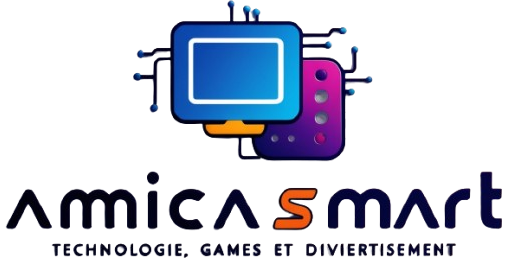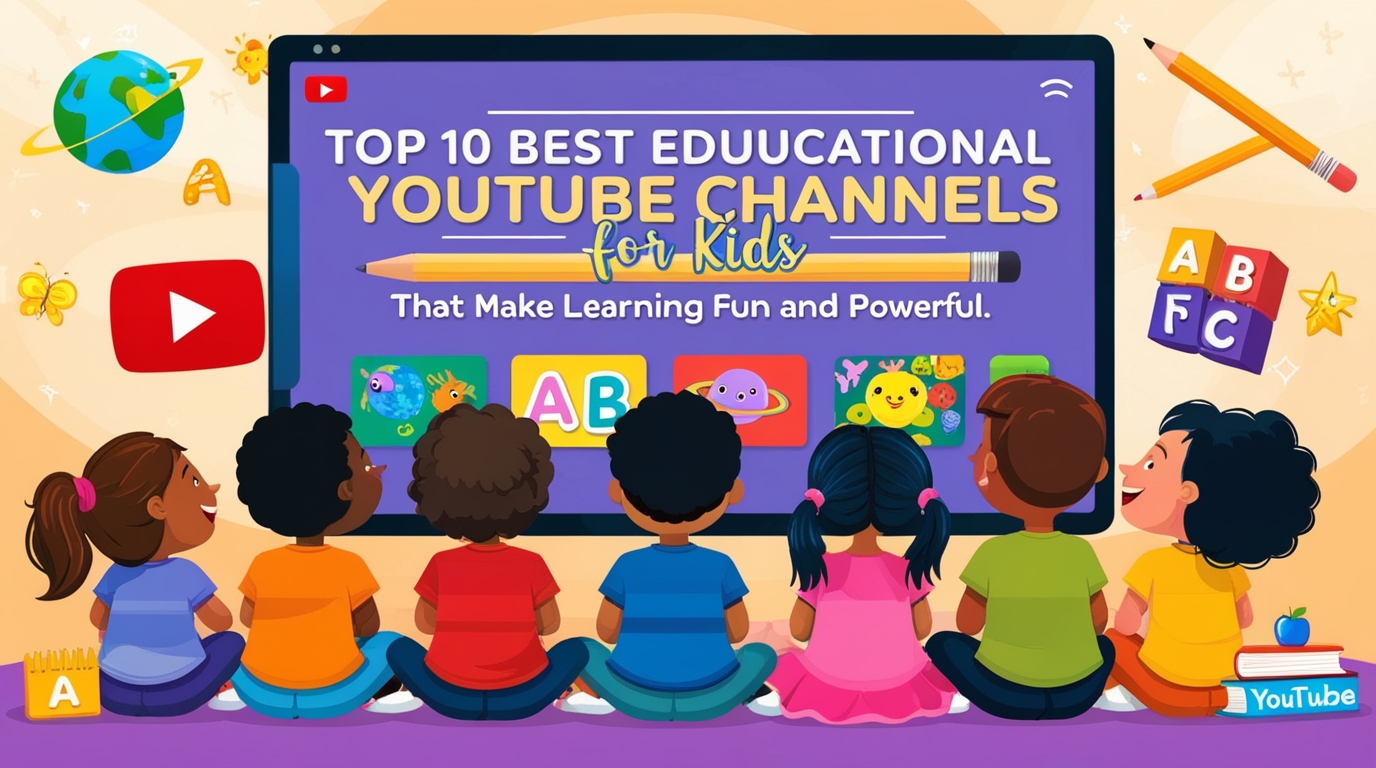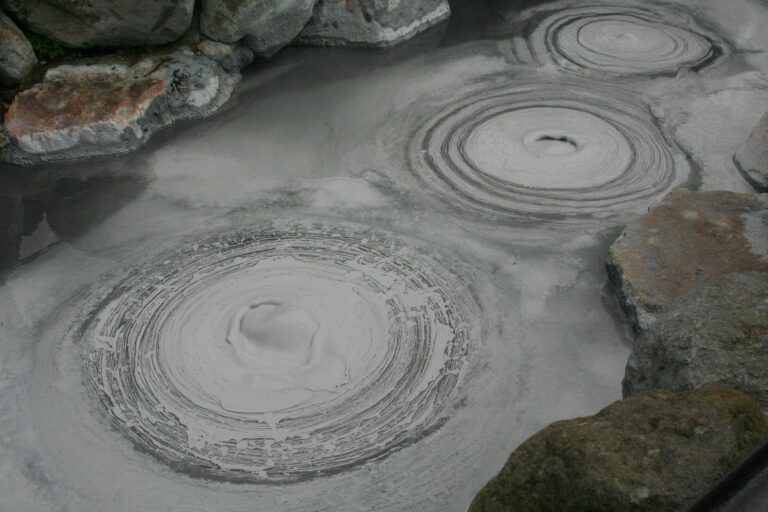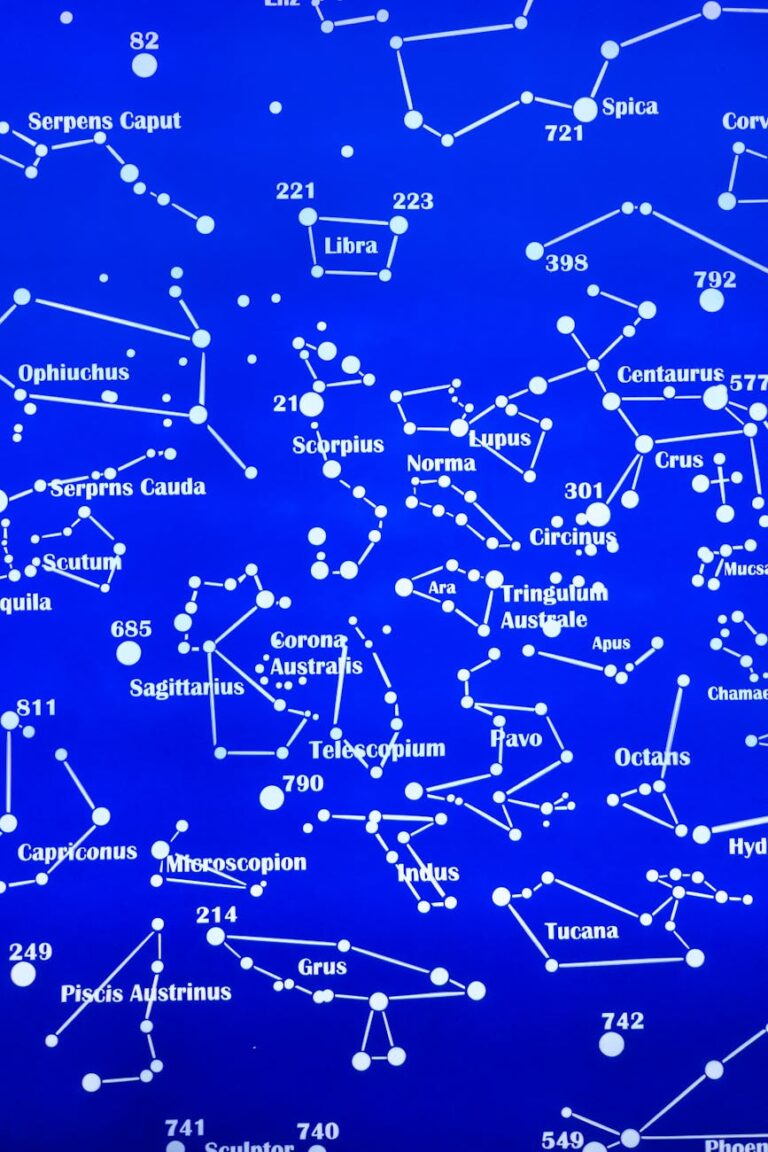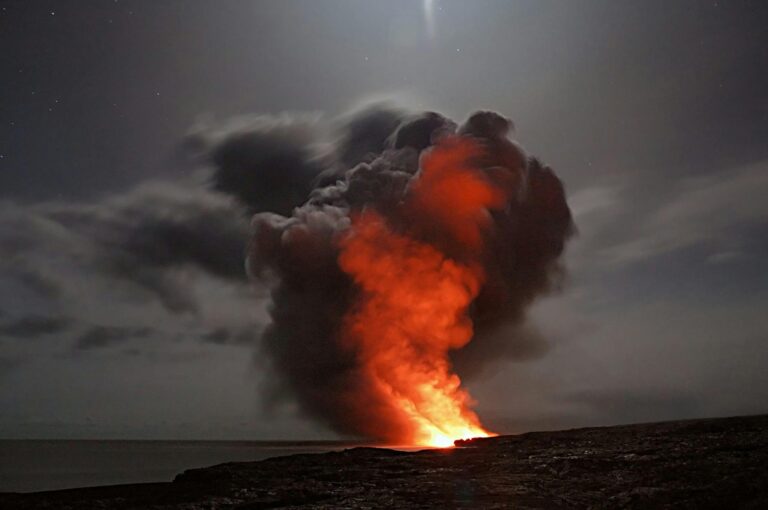Top 10 Best Educational YouTube Channels for Kids That Make Learning Fun and Powerful
Introduction
Educational YouTube Channels for Kids
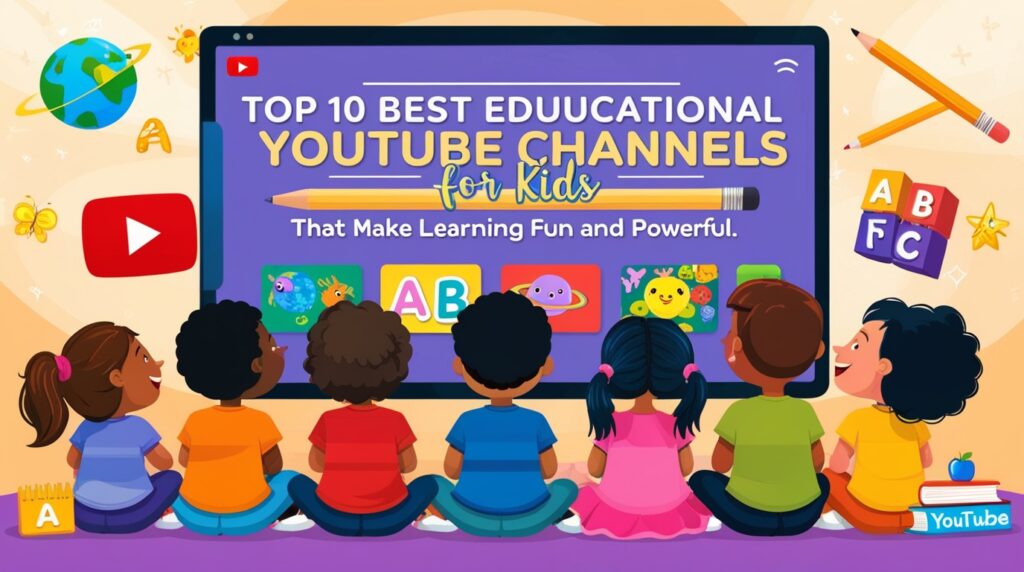
In the past decade, YouTube has transformed from a simple video-sharing platform into one of the most influential educational tools in the world. With billions of videos available, parents now have an abundance of choices for helping their children learn new things—from colors and shapes to science experiments and world geography. The best part? Kids love it. Bright visuals, catchy songs, and storytelling make YouTube an irresistible learning environment for curious young minds.
Educational YouTube channels for kids are now a major part of many households. Whether you’re a parent looking to teach your toddler their ABCs or a teacher searching for fun visual resources, there’s something for everyone. The accessibility of the internet means that learning isn’t limited to classrooms anymore—it’s happening right at home, one video at a time.
Why Parents Prefer YouTube for Kids’ Learning
Parents are turning to YouTube as an educational ally because it blends entertainment and education seamlessly. Instead of children spending hours on unproductive content, educational channels give them a chance to learn through fun songs, stories, and interactive animations. The content is often free, updated regularly, and available on-demand—perfect for busy families.
Moreover, YouTube Kids (a separate app designed for young viewers) offers filtered and safe content, giving parents peace of mind. Channels like “Cocomelon,” “Crash Course Kids,” and “National Geographic Kids” make learning dynamic and exciting. The wide variety ensures that no matter what subject your child is interested in—math, art, science, or geography—they’ll find something they love.
Benefits of Educational YouTube Channels for Kids
Combining Fun and Learning
One of the biggest reasons educational YouTube channels are so effective is that they make learning fun. Kids don’t even realize they’re studying because the content is engaging and visually appealing. For example, when toddlers watch “Cocomelon,” they learn about family values, sharing, and numbers through songs and relatable characters.
This fun-based learning approach keeps children motivated. The repetition in songs helps reinforce memory, while storytelling improves comprehension. When children enjoy what they’re watching, they retain information better and are more likely to develop a love for learning early on.
Accessibility and Flexibility of YouTube Learning
YouTube’s flexibility makes it ideal for modern families. Whether you’re at home, in the car, or waiting at the doctor’s office, educational videos are just a click away. Unlike traditional TV programs with fixed schedules, YouTube allows on-demand access, meaning your child can learn at their own pace.
Additionally, parents can create playlists tailored to their child’s educational goals—like phonics, animal facts, or space exploration. With subtitles, interactive visuals, and diverse languages available, YouTube content breaks geographical and linguistic barriers, making quality education accessible to all.
Safe and Age-Appropriate Content
Safety is a major concern for parents when it comes to online content. Thankfully, YouTube Kids provides a controlled environment where inappropriate material is filtered out. Parents can set time limits, block channels, and even monitor their child’s viewing history.
Many educational creators also follow strict child-friendly guidelines, ensuring that videos are respectful, educational, and safe. Channels like “Super Simple Songs” and “Little Baby Bum” have built massive reputations for maintaining a wholesome learning atmosphere.
Top Educational YouTube Channels for Preschoolers (Ages 2–5)
Cocomelon – Nursery Rhymes and Early Learning
Cocomelon has become a household name worldwide. The channel focuses on animated nursery rhymes and original songs that teach kids about everyday life, good manners, and social skills. With colorful animations and catchy tunes, it’s perfect for toddlers just starting to grasp language and rhythm.
Beyond just entertainment, Cocomelon’s songs are educational. Children learn about numbers, colors, shapes, and simple moral lessons like sharing, honesty, and kindness. The relatable family characters—JJ, TomTom, and YoYo—create a comforting and engaging learning experience.
Little Baby Bum – Songs and Numbers
Little Baby Bum is another fantastic YouTube channel that combines traditional nursery rhymes with fun animations. Its strength lies in helping children with early numeracy, literacy, and motor skills. Through repetitive and rhythmic songs, children effortlessly learn counting, colors, and even basic vocabulary.
Parents appreciate the channel’s gentle pace and soft visuals, making it ideal for winding down before bedtime. The repetitive content structure also supports language development and cognitive growth in early learners.
Super Simple Songs – Interactive Learning Through Music
Super Simple Songs is known for its minimalist animation style and clear, slow-paced singing—perfect for toddlers who are learning to speak or sing along. The channel offers both classic and original songs designed to teach language skills, emotions, and daily routines.
What sets it apart is the interactive nature of its content. Songs like “The Wheels on the Bus” and “Head, Shoulders, Knees and Toes” encourage children to move, sing, and participate actively. It’s a powerful way to enhance coordination and confidence while learning.
Best Educational YouTube Channels for Elementary Kids (Ages 6–10)
National Geographic Kids – Exploring the World
National Geographic Kids introduces young learners to the wonders of the world—from wildlife to science and geography. The videos are filled with stunning visuals, fascinating facts, and stories about real animals and cultures. Kids can explore different ecosystems, learn about endangered species, and develop a curiosity for the planet.
This channel promotes environmental awareness and a sense of global responsibility. It’s not just educational—it inspires kids to care about nature and become mini-explorers themselves.
Crash Course Kids – Fun Science and Experiments
Crash Course Kids takes complex topics like physics, biology, and engineering and turns them into fun, understandable lessons. Hosted by enthusiastic educators, each episode uses animations and real-world examples to simplify challenging concepts.
The channel encourages critical thinking and problem-solving through science experiments that kids can try at home. Whether it’s learning about ecosystems or the solar system, Crash Course Kids makes every subject engaging and practical.
TED-Ed – Creative Lessons for Curious Minds
TED-Ed offers short, animated educational videos created by teachers and animators from around the world. These lessons cover almost every topic imaginable—from history to biology to philosophy.
The storytelling approach, combined with creative visuals, keeps kids hooked. For older elementary students, TED-Ed is a great platform to inspire curiosity, creativity, and critical thinking. It helps kids ask “why” instead of just accepting facts.
Top Educational YouTube Channels for Tweens and Teens (Ages 11–16)
Khan Academy Kids – Comprehensive Learning
Khan Academy is a name synonymous with free, high-quality education. Their YouTube channel, along with the Khan Academy Kids app, provides a wide range of lessons for students at different grade levels. Covering subjects like math, science, grammar, and even art, Khan Academy simplifies complex topics into digestible and easy-to-understand videos.
For tweens and teens, this channel is a blessing. The lessons are structured in a way that aligns with school curriculums, helping students reinforce what they learn in class. The animated lessons and step-by-step tutorials make even difficult concepts—like algebra or grammar rules—feel approachable.
Parents love it because Khan Academy is ad-free and focused purely on education. Whether your child is catching up on a tough subject or exploring something new out of curiosity, this channel nurtures a lifelong love for learning.
SciShow Kids – Science Made Simple
If your child loves science or constantly asks “Why?”, then SciShow Kids is a must-watch. Hosted by the energetic and engaging Jessi, this channel dives into exciting scientific concepts—everything from how volcanoes erupt to why cats purr.
SciShow Kids explains these ideas in a way that’s easy to grasp, often using fun experiments and demonstrations. The visuals are bright and detailed, helping children visualize complex ideas. What’s remarkable is how the channel connects science to real life, showing kids that learning isn’t just about books—it’s about understanding the world around them.
Parents appreciate SciShow Kids because it promotes curiosity and critical thinking. It inspires children to ask questions, seek answers, and think like young scientists.
Homeschool Pop – Engaging Lessons Across Subjects
Homeschool Pop is another fantastic educational YouTube channel that covers a variety of subjects—history, geography, math, and social studies. Designed especially for homeschooled children, the channel’s content is perfect for learners who prefer visual and auditory instruction.
Each video is structured like a mini-lesson, often featuring a fun animated teacher guiding kids through the topic. Whether your child is learning about ancient civilizations or U.S. presidents, the lessons are engaging, clear, and memorable.
Parents and educators love Homeschool Pop because it promotes self-paced learning. Children can revisit videos, pause to take notes, or explore new subjects whenever they like. It’s like having a friendly online tutor available anytime.
How to Choose the Right Educational Channel for Your Child
Evaluating Content Quality and Credibility
Not all YouTube channels are created equal. When choosing an educational channel for your child, it’s important to look for credibility and content quality. Reputable channels often have educators, scientists, or experienced teachers behind them.
Look at factors such as accuracy, presentation style, and how often the channel uploads new videos. Channels like National Geographic Kids, TED-Ed, and Khan Academy maintain consistently high educational standards. Reading comments and checking the “About” section can also give you a sense of the channel’s authenticity and mission.
Parents should also pay attention to production quality. High-quality visuals, sound clarity, and engaging narration all contribute to better learning outcomes.
Checking Age Appropriateness
YouTube offers a vast library of content, but not all of it is suitable for every age. Always make sure the videos align with your child’s developmental stage. For example, preschoolers benefit most from channels like Cocomelon or Super Simple Songs, which focus on basic concepts and language development.
Older kids, however, might find these too simplistic. They’ll engage better with channels like Crash Course Kids or SciShow Kids, which challenge their critical thinking and curiosity.
It’s also wise to use the YouTube Kids app, which filters out inappropriate content automatically and allows parents to select age categories.
Considering Your Child’s Interests and Learning Style
Every child learns differently. Some kids absorb information best through music and visuals, while others prefer hands-on demonstrations or storytelling. Understanding your child’s learning style can help you pick the most effective channel.
For example:
- Auditory learners thrive with music-based channels like Super Simple Songs.
- Visual learners benefit from animations in TED-Ed or Crash Course Kids.
- Kinesthetic learners enjoy interactive and experimental content like SciShow Kids.
When kids enjoy what they’re watching, learning happens naturally. The key is to combine education with entertainment—something YouTube does perfectly.
The Role of Parents in YouTube Learning
Setting Screen Time Limits
While educational videos are great, moderation is key. Too much screen time can strain eyes and reduce physical activity. The American Academy of Pediatrics recommends limiting screen time for young children to one hour per day of high-quality programming.
Parents should set daily or weekly viewing schedules, balancing online learning with outdoor play, reading, and family interaction. Creating a structured routine helps children enjoy YouTube responsibly without overindulging.
You can use built-in YouTube Kids timers or parental control apps to help enforce these limits automatically.
Watching Together and Discussing Content
Children learn best when parents are involved. Watching videos together allows parents to turn passive viewing into active learning. Ask questions, discuss what was shown, and encourage your child to share their thoughts.
For example, after watching a Crash Course Kids video on the water cycle, you might ask, “Can you explain what happens when it rains?” This helps reinforce the lesson and builds communication skills.
Watching together also helps parents monitor what their kids are exposed to and steer them toward positive content.
Using Parental Controls for Safety
Safety on YouTube is non-negotiable. Fortunately, there are tools to help parents ensure their kids stay protected online. Using YouTube Kids, you can filter videos, approve specific channels, and block any that seem questionable.
Additionally, enabling Restricted Mode on regular YouTube helps filter out mature or inappropriate content. It’s also good practice to disable comments on videos when possible, as this prevents exposure to unfiltered interactions.
Remember, YouTube is a fantastic educational platform—but only when used wisely under parental supervision.
The Future of Educational YouTube Content for Kids
AI and Interactive Learning Videos
The future of YouTube learning is exciting. With artificial intelligence and interactive tools, kids may soon be able to interact directly with videos—answering quizzes, making choices, or customizing lessons in real time.
This kind of learning transforms videos from one-way content into interactive experiences. Imagine a child watching a science video and being able to pause and perform a mini-experiment guided by the AI. That’s the direction we’re heading.
Collaboration Between Educators and Content Creators
As educational demand grows, more teachers and schools are collaborating with content creators to produce accurate, curriculum-aligned material. Channels like TED-Ed already invite educators worldwide to contribute ideas for animated lessons.
This collaboration ensures that YouTube remains not just fun but academically reliable, bridging the gap between formal education and online learning.
The Rise of Edutainment
“Edutainment”—a blend of education and entertainment—is the future of children’s learning online. The most successful YouTube channels are those that strike this balance perfectly. Whether it’s catchy songs teaching math or animated stories explaining history, edutainment keeps children engaged while they learn.
As attention spans shrink and digital media evolves, content that combines creativity, fun, and learning will dominate YouTube’s educational space.
Conclusion
Educational YouTube channels have revolutionized how kids learn. They make education accessible, enjoyable, and engaging—something that traditional classrooms sometimes struggle to achieve. From colorful nursery rhymes for toddlers to science experiments for teens, YouTube provides endless opportunities for growth and discovery.
As parents, the goal is not to eliminate screen time but to guide it wisely. By choosing the right channels, setting boundaries, and participating in your child’s learning journey, you can transform screen time into meaningful educational moments.
YouTube, when used responsibly, can be one of the best teachers your child ever has.
FAQs
1. Are YouTube educational channels safe for kids?
Yes, when using platforms like YouTube Kids or parental controls, educational channels are generally safe. Always monitor viewing habits and check channel credibility.
2. What age is best for educational YouTube videos?
Educational videos cater to all ages—from toddlers to teens. The key is choosing content suitable for your child’s developmental level.
3. Can YouTube replace traditional education?
Not entirely. YouTube complements formal education by offering visual and interactive reinforcement, but structured classroom learning remains essential.
4. How much screen time is recommended for kids?
Experts recommend limiting screen time for young kids to about one hour per day of quality content.
5. What are some of the best educational YouTube channels for kids?
Top choices include Cocomelon, Super Simple Songs, Crash Course Kids, TED-Ed, Khan Academy Kids, and SciShow Kids.
